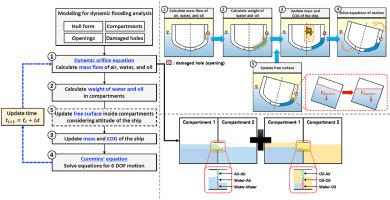当前位置:
X-MOL 学术
›
Ocean Eng.
›
论文详情
Our official English website, www.x-mol.net, welcomes your
feedback! (Note: you will need to create a separate account there.)
Dynamic flooding analysis method for intermediate flooding process of a ship
Ocean Engineering ( IF 4.6 ) Pub Date : 2020-12-01 , DOI: 10.1016/j.oceaneng.2020.108173 Ki-Su Kim , Myung-Il Roh
Ocean Engineering ( IF 4.6 ) Pub Date : 2020-12-01 , DOI: 10.1016/j.oceaneng.2020.108173 Ki-Su Kim , Myung-Il Roh

|
Abstract To guarantee the safety of a ship by preventing accidents, various regulations, including those related to the ship design, must be followed. Despite these efforts, accidents may occur. Personnel injury or oil spill are highly probable during an accident. Therefore, this study proposes a method for analyzing the intermediate state of flooding to predict the motion of the ship, and the amount of flooded water and spilled oil during an accident. Quasi-static analysis has been primarily used for intermediate flooding analysis. However, limitations exist with respect to dynamic effects and ocean environmental loads. To overcome these limitations, a dynamic flooding analysis method is proposed in this study. Cummins’ equation is used to analyze the six-degrees-of-freedom motion of a ship, while the dynamic orifice equation is used to calculate the flow rate through damaged holes and openings in the ship. Additionally, a method is proposed to consider the oil spill over a period. This method is verified in comparison with other studies, and its feasibility is confirmed using three case studies of a Navy oiler.
中文翻译:

船舶中间浸水过程动态浸水分析方法
摘要 为了防止事故的发生,保障船舶安全,必须遵守各种规定,包括与船舶设计有关的规定。尽管做出了这些努力,事故还是可能发生。事故中极有可能造成人员受伤或漏油。因此,本研究提出了一种分析浸水中间状态的方法,以预测船舶的运动,以及事故期间浸水和溢油的量。准静态分析主要用于中间洪水分析。然而,在动力效应和海洋环境负荷方面存在局限性。为了克服这些限制,本研究提出了一种动态洪水分析方法。康明斯方程用于分析船舶的六自由度运动,而动态孔口方程用于计算通过船舶损坏孔洞和开口的流量。此外,还提出了一种考虑一段时间内漏油的方法。与其他研究相比,该方法得到了验证,并通过海军油船的三个案例研究证实了其可行性。
更新日期:2020-12-01
中文翻译:

船舶中间浸水过程动态浸水分析方法
摘要 为了防止事故的发生,保障船舶安全,必须遵守各种规定,包括与船舶设计有关的规定。尽管做出了这些努力,事故还是可能发生。事故中极有可能造成人员受伤或漏油。因此,本研究提出了一种分析浸水中间状态的方法,以预测船舶的运动,以及事故期间浸水和溢油的量。准静态分析主要用于中间洪水分析。然而,在动力效应和海洋环境负荷方面存在局限性。为了克服这些限制,本研究提出了一种动态洪水分析方法。康明斯方程用于分析船舶的六自由度运动,而动态孔口方程用于计算通过船舶损坏孔洞和开口的流量。此外,还提出了一种考虑一段时间内漏油的方法。与其他研究相比,该方法得到了验证,并通过海军油船的三个案例研究证实了其可行性。









































 京公网安备 11010802027423号
京公网安备 11010802027423号